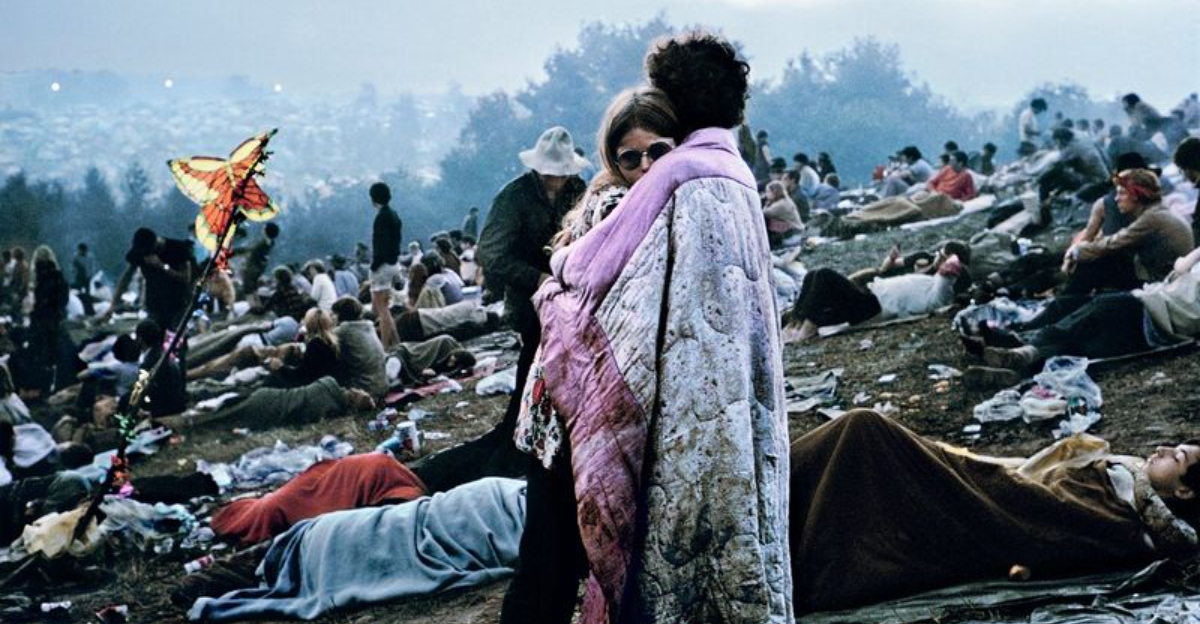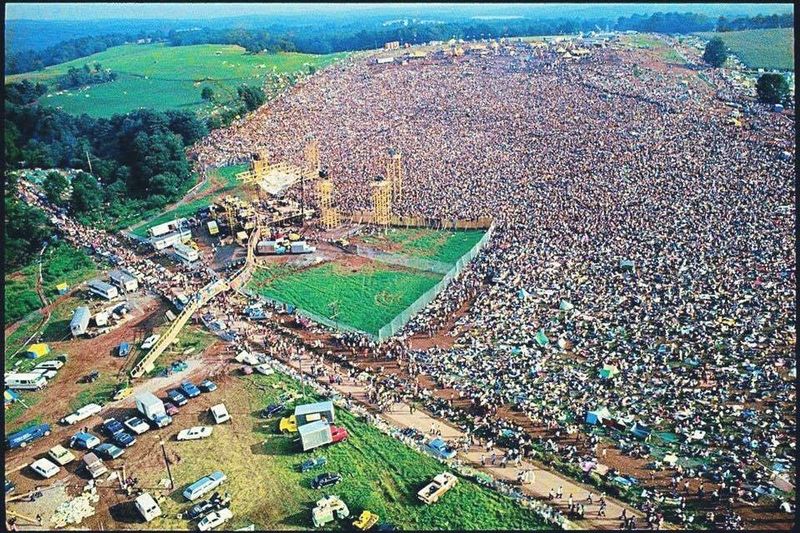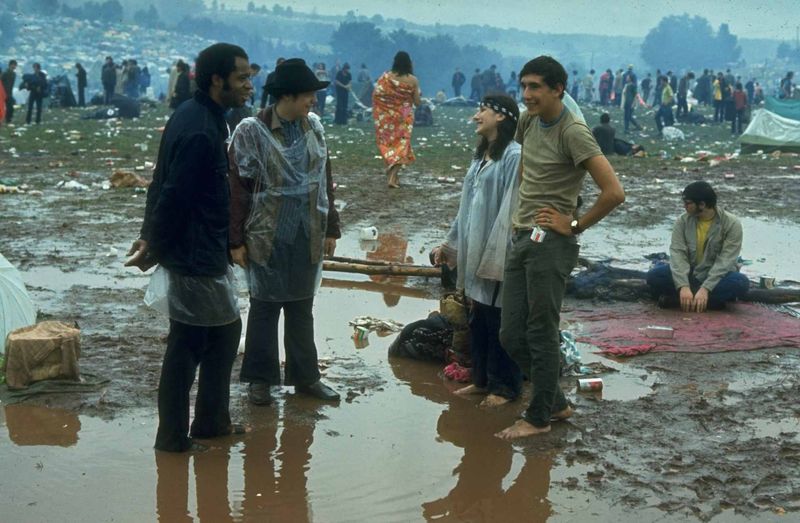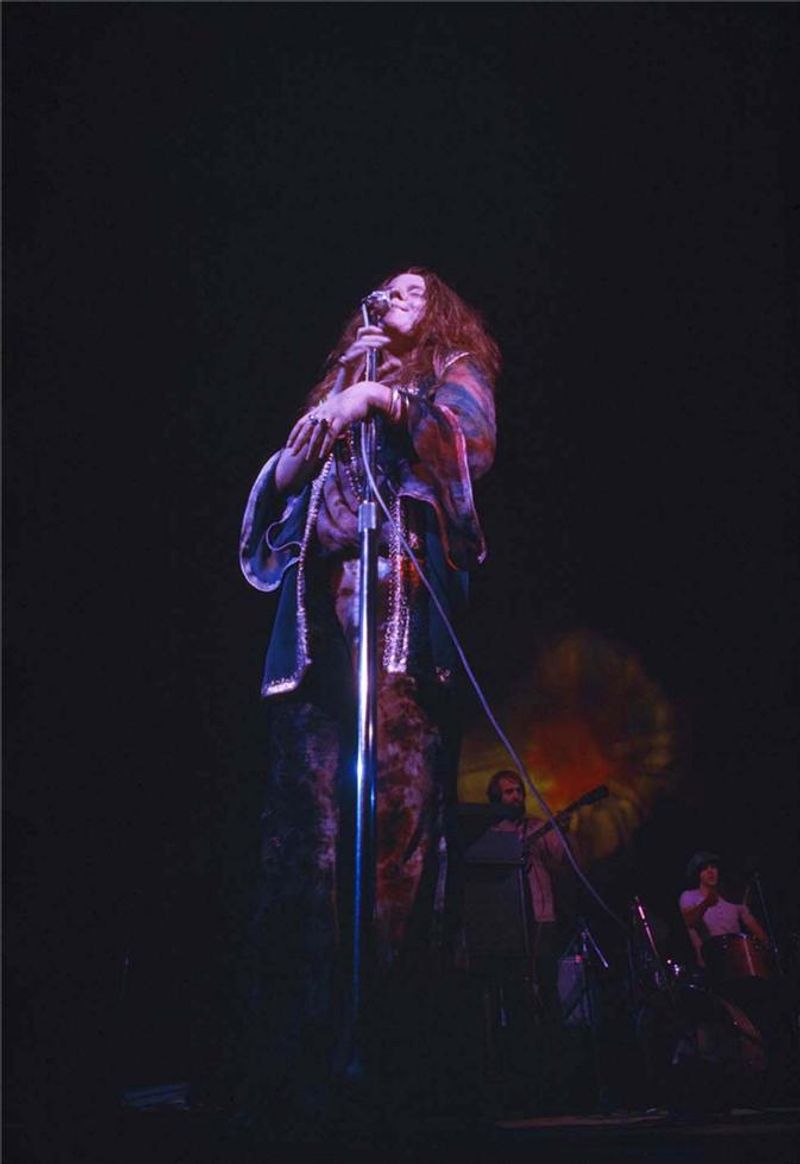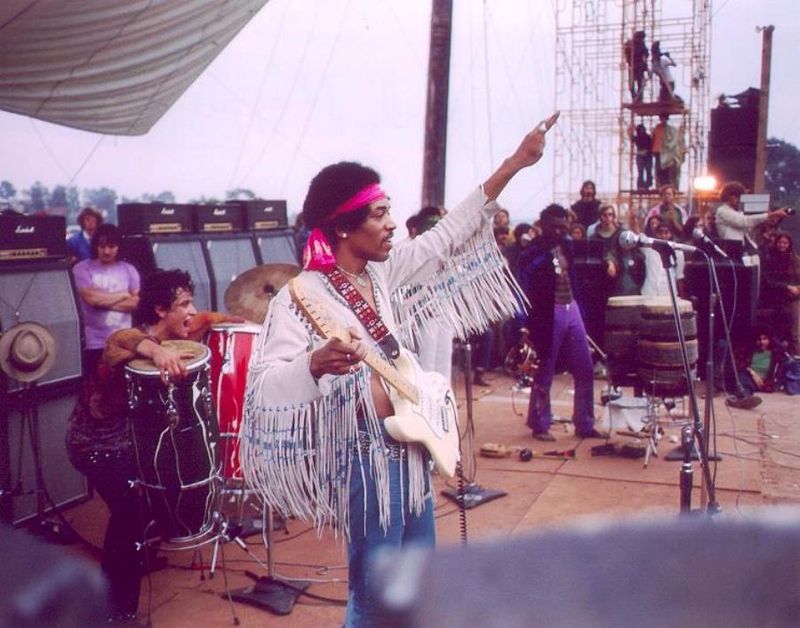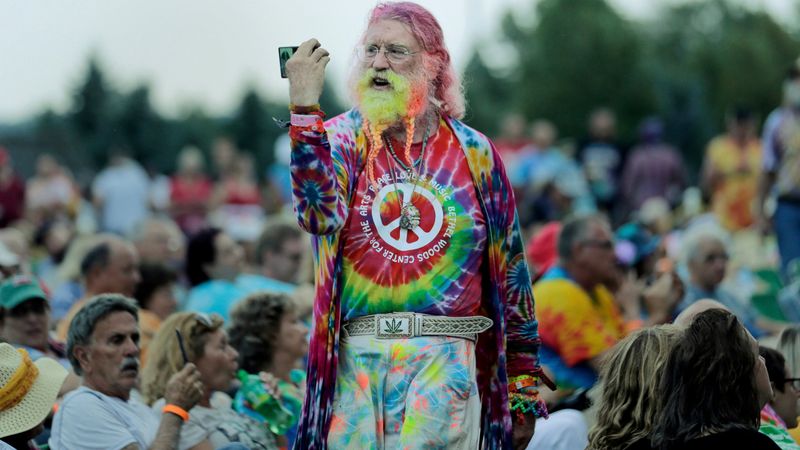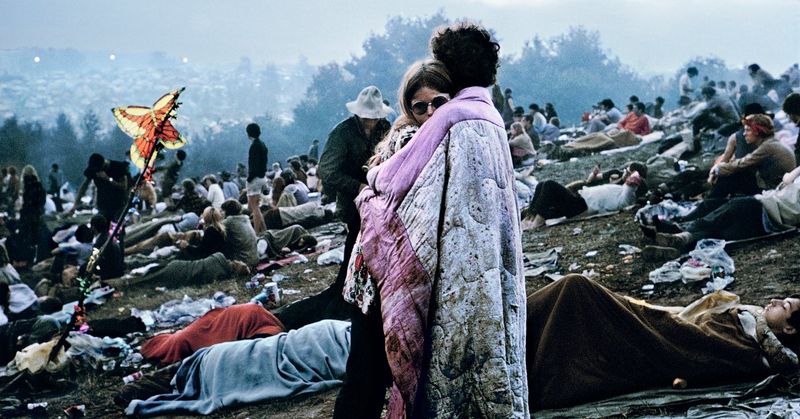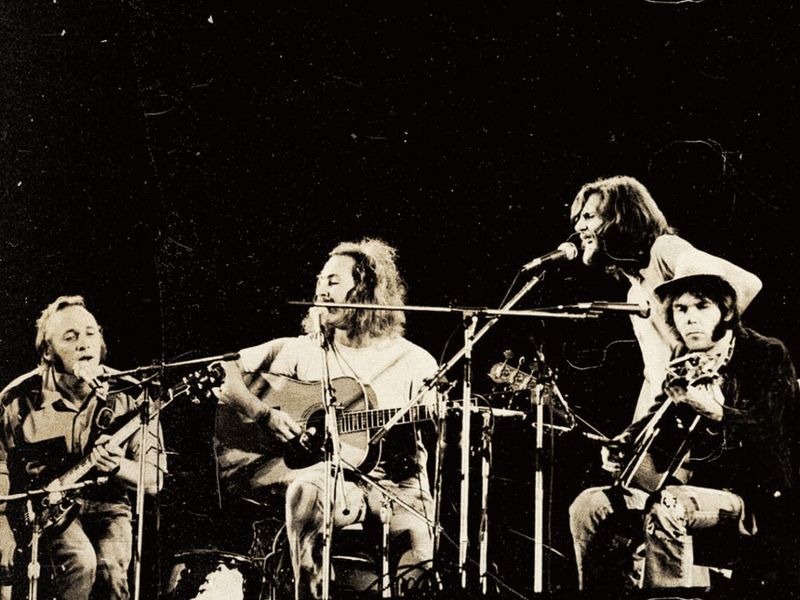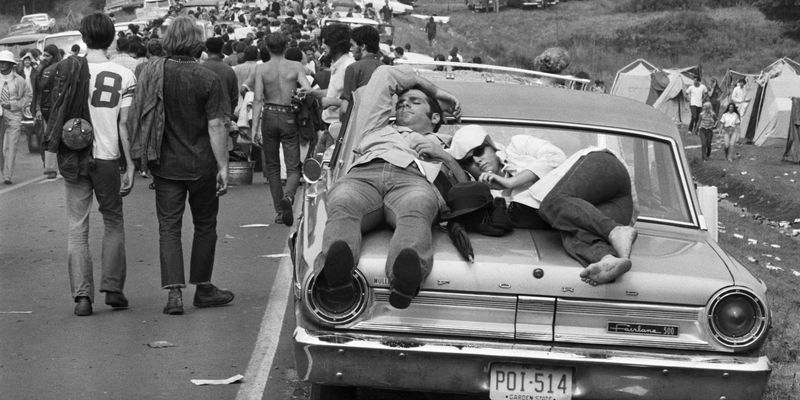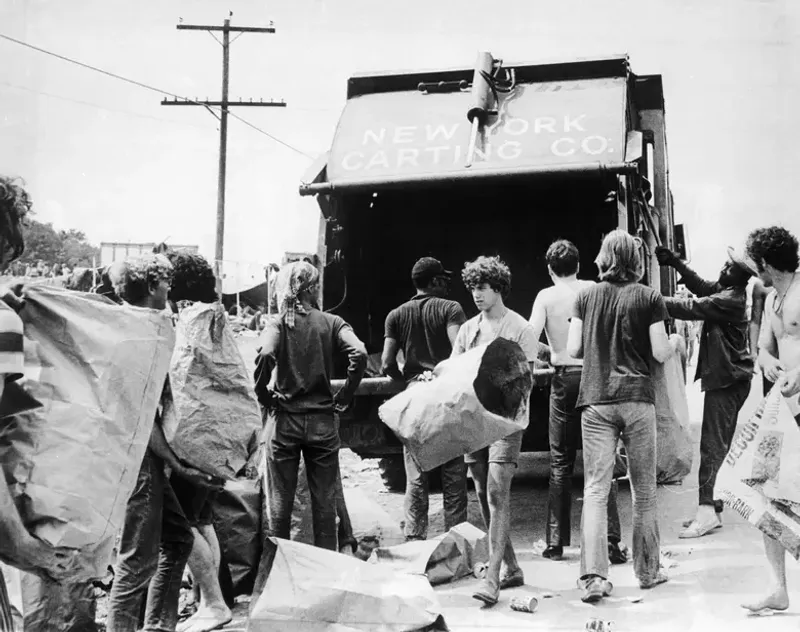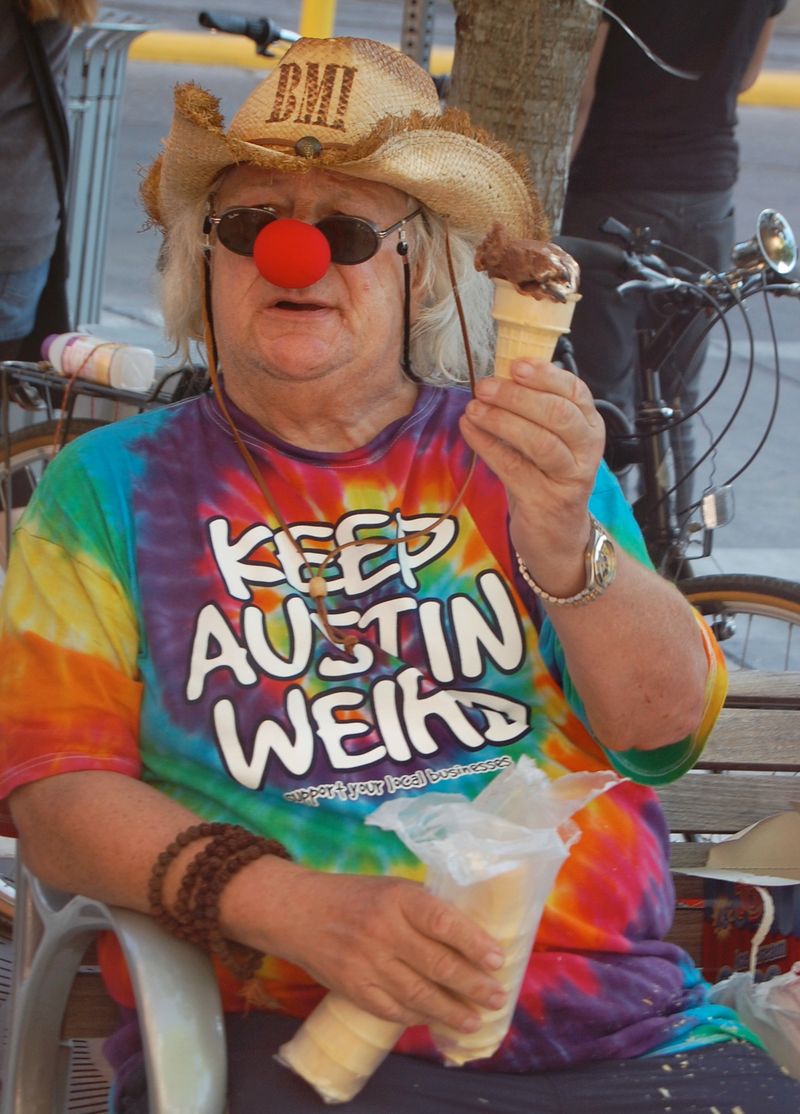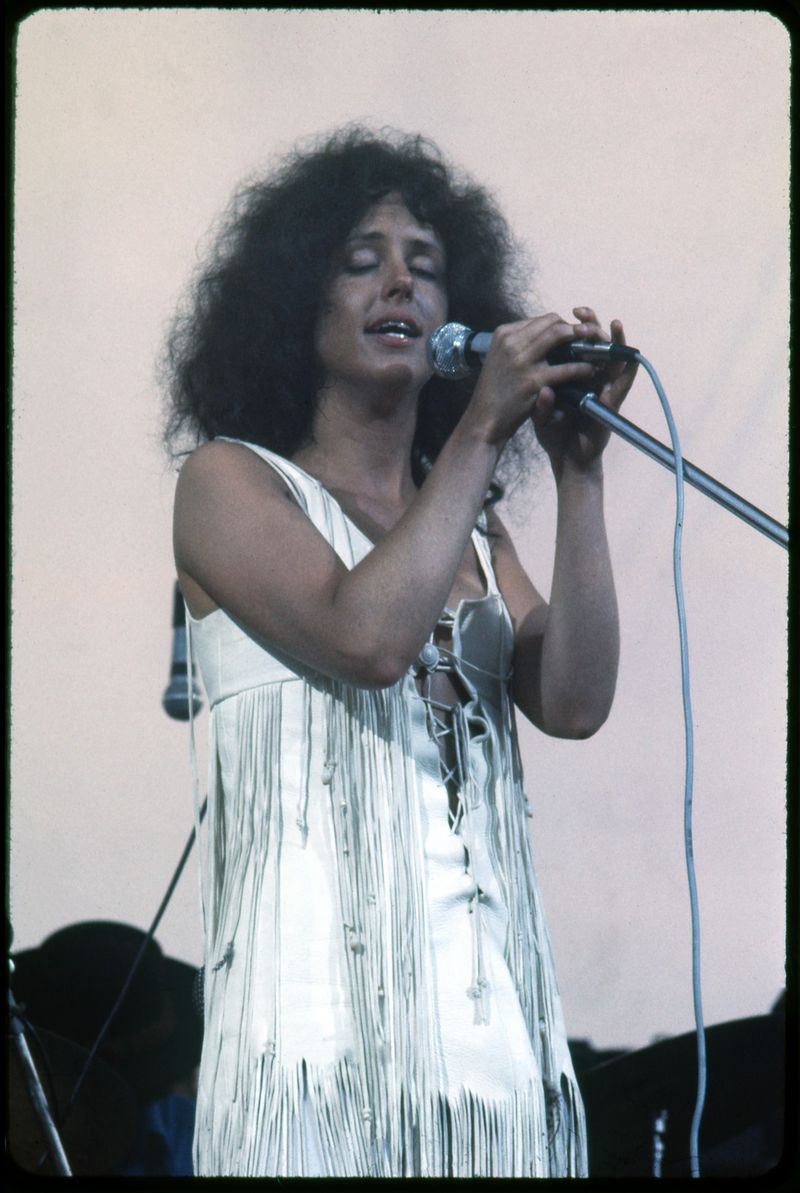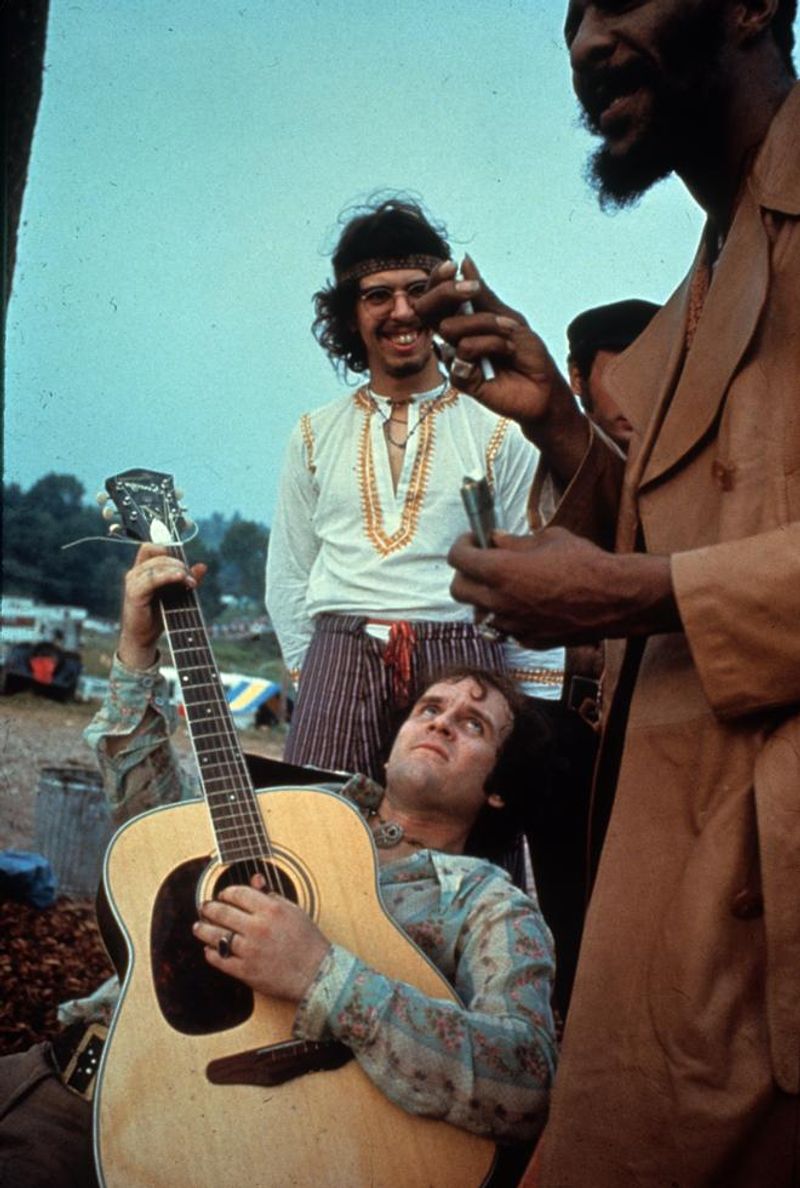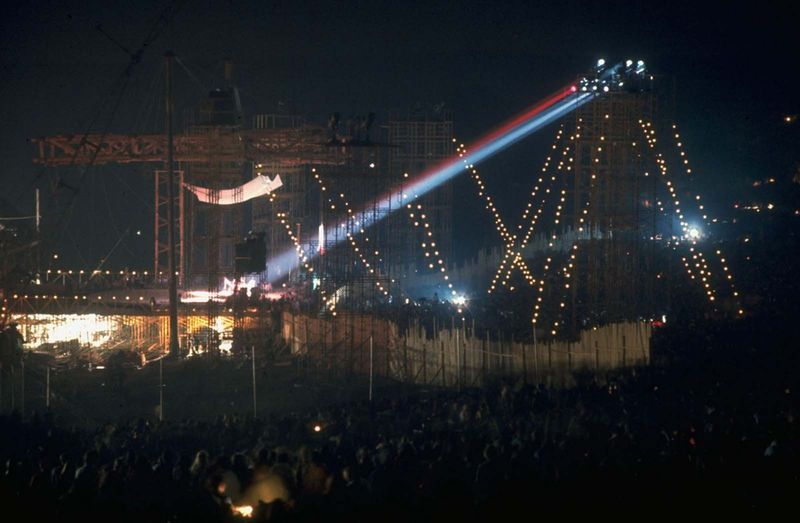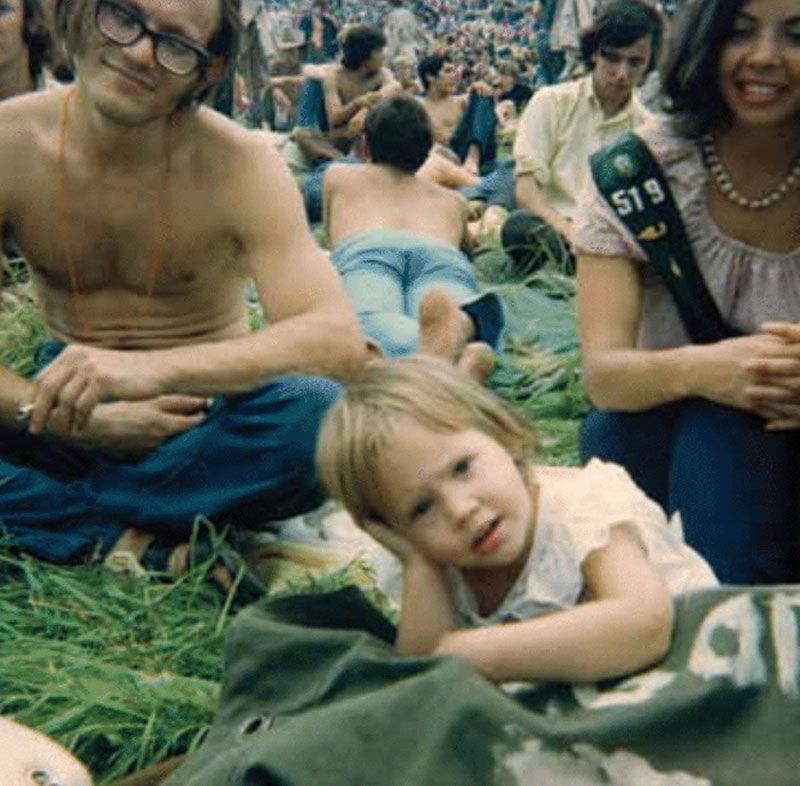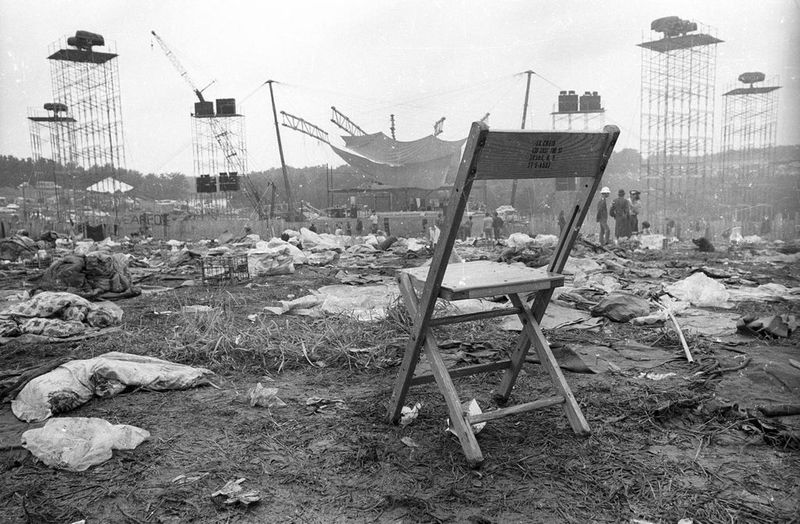The summer of 1969 brought us Woodstock, a music festival that defined an era. For three days, almost half a million people gathered on a dairy farm in upstate New York to celebrate peace, music, and togetherness during a time of war and social upheaval. These photographs capture more than just a concert—they reveal the heart and soul of the counterculture movement that changed America forever.
1. Crowd of 400,000 – A sea of people stretching to the horizon
From the air, they resembled ants at a picnic—hundreds of thousands of young people covering the rolling hills of Max Yasgur’s farm. Nobody expected such an enormous turnout. Festival organizers planned for 50,000 attendees but were overwhelmed when nearly half a million showed up.
Cars abandoned on roadsides forced many to walk miles to reach the festival grounds. The sheer magnitude of humanity gathered peacefully in one place remains unprecedented even today.
This aerial shot perfectly captures what made Woodstock legendary: not just the music, but the astonishing demonstration that so many people could come together in harmony despite challenging conditions.
2. Mud-Sliding Festival-Goers – Happy attendees playing in the rain and mud
When summer storms turned the festival grounds into a giant mud pit, attendees didn’t pack up and leave—they embraced it! Young men and women, many completely naked, transformed the muddy hillsides into natural waterslides, laughing and sliding downhill together.
Rather than complaining about ruined clothes or wet sleeping bags, festival-goers found joy in the messy situation. The mud became part of Woodstock’s charm and a symbol of the carefree attitude that defined the gathering.
This playful moment showcases the resilient spirit of a generation determined to find happiness even in uncomfortable circumstances—making lemonade from lemons, or in this case, waterslides from mudslides.
3. Janis Joplin’s Electrifying Performance – The soulful singer belting out hits on stage
Raw emotion poured from every note as Janis took command of the Woodstock stage. Her raspy, powerful voice cut through the night air at 2 AM, captivating thousands despite the late hour. Dressed in colorful, flowing fabrics with beads adorning her wrists and feathers in her wild hair, she embodied the festival’s free spirit.
Photographers captured her mid-belting “Piece of My Heart,” eyes closed in complete surrender to the music. Few performers connected with audiences as authentically as Janis.
Just over a year later, she would be gone forever, making these images even more precious—frozen moments of a blazing talent who burned too brightly and too briefly.
4. Jimi Hendrix’s Legendary Guitar Solo – His iconic rendition of The Star-Spangled Banner
Monday morning, 8:30 AM. Most festival-goers had already departed when Jimi Hendrix stepped onto the stage. What followed became the most iconic moment in rock history—his mind-bending interpretation of the national anthem that transformed patriotic melody into protest art.
Cameras captured Hendrix hunched over his white Stratocaster, eyes closed in concentration, fingers dancing across the fretboard. The distorted notes mimicked bombs dropping and screaming missiles, a powerful commentary on America’s involvement in Vietnam.
Only 30,000 witnessed this performance live, but this photograph preserves the moment when music transcended entertainment to become a political statement that would echo through generations of musicians seeking to speak truth through their art.
5. Peace Signs & Flower Crowns – Hippies flashing peace signs and wearing flowers in their hair
Nothing symbolized the counterculture movement quite like the two-fingered peace sign paired with flowers woven into long, flowing hair. Young women with daisy chains adorning their foreheads smiled for the camera while flashing the gesture that had become shorthand for their generation’s values.
These weren’t just fashion statements but visible rejections of war and violence. The simple hand gesture originated from anti-nuclear protests in Britain before being adopted by American peace activists.
Photographers captured groups of friends sitting in circles, making these symbols while passing around shared cigarettes and food—visual evidence of a generation believing they could change the world through peace, love, and understanding rather than conflict and competition.
6. Couple Wrapped in a Blanket – A young pair huddled together in the crowd
Immortalized by photographer Burk Uzzle, this intimate moment between Nick Ercoline and Bobbi Kelly became Woodstock’s most enduring image. The young couple stands wrapped in a muddy blanket, his arm protectively around her shoulders as they gaze across the festival landscape at dawn.
Neither knew they were being photographed. The image later graced the Woodstock album cover and film poster, transforming these ordinary teenagers into unwitting symbols of the festival’s spirit of love and togetherness.
Remarkably, Nick and Bobbi married the following year and remain together today—their relationship outlasting many of the bands that performed. Their enduring love story adds another layer of meaning to this candid photograph of two souls finding shelter in each other amid chaos.
7. Crosby, Stills & Nash Harmonizing – The folk-rock trio performing under the sun
“This is only the second time we’ve performed in public,” Stephen Stills nervously told the massive crowd. The supergroup—formed just months earlier—delivered one of Woodstock’s most memorable sets despite their inexperience together.
Photographers captured the three musicians huddled around their microphones, their distinctive vocal blend cutting through the afternoon air. David Crosby’s fringe jacket, Nash’s earnest expressions, and Stills’ intense concentration show three artists finding their collective voice in real time.
Their harmonies on “Suite: Judy Blue Eyes” and “Marrakesh Express” provided the perfect soundtrack for the peaceful gathering. This photo preserves the birth of a musical partnership that would influence generations of musicians with their politically conscious lyrics and perfect vocal blend.
8. The Famous “Woodstock” Sign – The hand-painted festival entrance arch
Crafted from plywood and enthusiasm rather than professional materials, the hand-painted “Woodstock Music & Art Fair” entrance sign welcomed half a million people to three days that would change music history. Its uneven lettering and homemade quality perfectly captured the festival’s grassroots spirit.
Festival-goers posed beneath the arch, flashing peace signs and smiles, unaware they were standing at the gateway to cultural legend. The sign’s creators never imagined their humble artwork would become one of the most recognizable symbols of the 1960s.
After the festival, the sign disappeared—likely dismantled or taken as a souvenir by an attendee who recognized its significance. This photograph remains one of the few records of the original entrance that marked the threshold between ordinary life and extraordinary experience.
9. Volunteers Helping the Crowd – Medical tents and free food being distributed
When supplies ran short, the spirit of sharing took over. Local residents and festival volunteers formed human chains passing sandwiches and water to hungry attendees stranded far from food vendors. Medical tents staffed by volunteer doctors treated everything from minor cuts to drug reactions.
The U.S. Army even helped, sending helicopters to drop medical supplies and transport performers when roads became impassable. These unexpected heroes—many wearing simple t-shirts with red crosses hastily painted on—worked tirelessly through heat, rain, and mud.
This powerful image shows strangers caring for strangers, creating an impromptu community where resources were freely shared. For many attendees, this experience of unconditional giving left a deeper impression than any musical performance.
10. The Hog Farm Commune – The hippie group that provided food and security
When festival organizers realized they needed help managing the unexpected crowds, they called the Hog Farm—a New Mexico commune led by the legendary Wavy Gravy. Flown in on chartered planes, these long-haired peacekeepers became Woodstock’s unlikely heroes.
Instead of traditional security, they created “Please Force” rather than “Police Force.” Armed with cream pies and seltzer bottles, they defused tense situations with humor rather than force. Their free kitchen served brown rice and vegetables to thousands from giant communal pots.
This photograph shows commune members in their colorful bus preparing food for the masses. Their compassionate approach to crowd management became a blueprint for how large gatherings could operate with minimal rules yet maximal cooperation—proving that peace and sharing weren’t just hippie ideals but practical solutions.
11. Grace Slick & Jefferson Airplane’s Sunrise Set – The band playing as dawn broke
The sky turned from black to purple to pink as Jefferson Airplane took the stage at 8 AM Sunday morning. Grace Slick’s powerful voice cut through the misty dawn air, awakening exhausted festival-goers with “Somebody to Love” and “White Rabbit.”
This remarkable photograph captures Slick in her element—confident and commanding despite the unusual hour. Her white outfit stands in stark contrast to the colorful stage lights mixing with the first rays of morning sun.
Many attendees consider this sunrise performance a spiritual experience, with nature and music aligning perfectly. The image preserves that magical moment when night became day and thousands of weary souls found renewed energy through music that seemed to summon the sun itself from behind the distant hills.
12. Guitars Around a Campfire – Musicians jamming together between sets
Away from the main stage, magic happened in small circles throughout the festival grounds. Attendees with guitars, harmonicas, and hand drums formed impromptu jam sessions that lasted deep into the night, sharing songs and stories around flickering campfires.
Professional musicians often wandered into these gatherings, sitting cross-legged on blankets to join unknown players in musical conversation. Folk songs passed from generation to generation mixed with newly written protest anthems and covers of the day’s popular hits.
This intimate photograph captures the festival’s true spirit better than any main stage shot. Here, the artificial boundary between performer and audience disappeared completely, revealing music’s power to connect strangers through shared experience—the essence of Woodstock distilled into one perfect frame.
13. The Woodstock Stage – The massive, makeshift platform with performers
Hastily constructed and nearly toppled by storms, the massive wooden platform became hallowed ground for three days in August 1969. The stage’s distinctive curved canopy—designed to protect equipment from rain—created an iconic silhouette against the rural landscape.
Built to accommodate bands ranging from acoustic folk duos to full rock ensembles with drum kits and amplifiers, the structure somehow survived despite engineering concerns. Photographers captured its evolution from empty platform to music’s most important altar, with performers dwarfed by the scale of both stage and audience.
What makes this image particularly poignant is knowing the stage was dismantled days after the festival ended. This temporary structure launched eternal legends, its wooden planks soaking up performances that would echo through music history long after they were reduced to splinters.
14. A Baby Born at Woodstock – The newborn who became a symbol of the festival
Amid music and mud, life began. When a festival attendee went into labor, fellow concertgoers quickly formed a human chain to help medical volunteers reach her through the dense crowd. Shortly after, a baby boy entered the world in a medical tent while Santana played nearby.
This remarkable photograph shows the newborn wrapped in blankets, surrounded by smiling volunteers and his exhausted but joyful mother. News of the birth spread through the festival like wildfire, becoming an instant symbol of Woodstock’s life-affirming spirit.
For decades, rumors circulated about “Woodstock babies,” but only two births were officially documented. This image captures one of those miraculous moments when even in chaotic conditions, strangers came together to welcome new life—the ultimate testament to peace and love.
15. Final Empty Field After the Crowd Left – The aftermath of three days of peace and music
Monday afternoon revealed what 400,000 people had left behind. The once-green pasture now resembled a surreal landscape—abandoned sleeping bags, crushed food containers, and countless personal items scattered across trampled earth.
Local teenagers earned money helping with cleanup, filling countless trash bags with the physical remnants of the weekend. Oddly beautiful in its desolation, the empty field bore witness to what had transpired there just hours before.
This haunting photograph shows Max Yasgur’s farm returning to silence, with only debris and memories remaining. The contrast between the vibrant, people-filled images and this empty aftermath creates a powerful visual coda to the festival—a reminder that even the most transformative experiences eventually end, leaving only their impact on those who were there.
